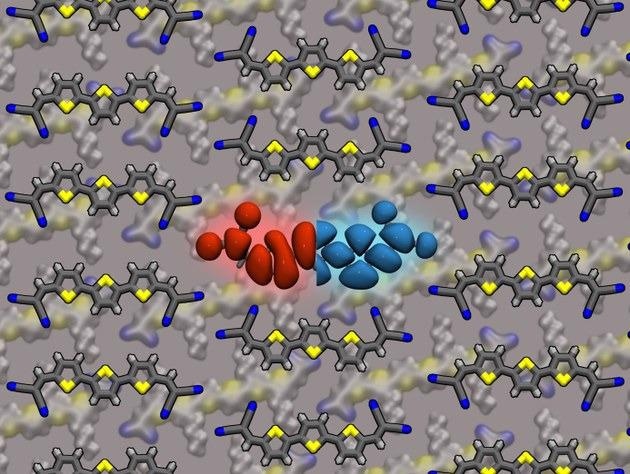Jun 11 2021
What was already established for inorganic semiconductors continues to be a challenge for their organic counterparts — that is, tuning the energy gap by mixing various semiconducting molecules to improve the performance of the device.
 Varying the ratio of 3T molecules (foreground) and 6T molecules (indicated in the background) in the blend allows tuning the gap continuously. Image Credit: Technische Universität Dresden.
Varying the ratio of 3T molecules (foreground) and 6T molecules (indicated in the background) in the blend allows tuning the gap continuously. Image Credit: Technische Universität Dresden.
Researchers from Technische Universität Dresden (TU Dresden), in collaboration with scientists from TU Munich, the University of Würzburg, HU Berlin, and Ulm University, have now demonstrated how to achieve this goal.
Organic semiconductors have gained a reputation as energy-efficient materials in organic light-emitting diodes (OLEDs) that are used in large-area displays. In these and other kinds of applications, like solar cells, a major parameter is the energy gap that exists between electronic states.
This energy gap determines the wavelength of the light that is produced or absorbed. The constant tuning of this energy gap is actually preferred. As a matter of fact, a suitable technique — the so-called blending — already exists for inorganic materials. This technique is based on designing the band gap by replacing atoms in the material. This enables a constant tunability as, for instance, in aluminum gallium arsenide semiconductors.
Regrettably, this cannot be transferred to organic semiconductors due to their different physical properties and their molecule-based construction paradigm; therefore, this makes constant band gap tuning much more complicated.
But with their new publication, the researchers from the Center for Advancing Electronics Dresden (cfaed, TU Dresden) and from the Cluster of Excellence “e-conversion” at TU Munich along with associates from the University of Würzburg, HU Berlin, and Ulm University realized energy-gap engineering for organic semiconductors by blending, which represented the first-of-its-kind achievement.
In the case of inorganic semiconductors, the energy levels can be moved toward one another by atomic substitutions, thereby decreasing the band gap (“band-gap engineering”). On the other hand, band structure modifications by mixing organic materials can only move the energy levels concertedly either up or down. This is because of the powerful Coulomb effect that can be manipulated in organic materials, but this has no impact on the gap.
It would be very interesting to also change the gap of organic materials by blending, to avoid the lengthy synthesis of new molecules.
Karl Leo, Professor, Technische Universität Dresden
Now, the team has discovered an unconventional approach by mixing the material with mixtures of analogous molecules of diverse sizes.
The key finding is that all molecules arrange in specific patterns that are allowed by their molecular shape and size. This induces the desired change in the material´s dielectric constant and gap energy.
Frank Ortmann, Professorand Group Leader at Center for Advancing Electronics, Technische Universität Dresden
Frank Ortmann’s team was able to explain the mechanism by replicating the structures of the blended films and their dielectric and electronic properties. An equivalent change in the molecular packing based on the shape of the blended molecules was verified by X-ray scattering measurements, carried out by the Organic Devices Group of Professor Stefan Mannsfeld at cfaed. Katrin Ortstein and her collaborators from the group of Professor Karl Leo, TU Dresden performed this core experimental and device work.
The study results were recently published in the leading journal, Nature Materials. While this confirms the possibility of this kind of energy-level engineering strategy, its use will be examined for optoelectronic devices in the days to come.
The study was financially supported by the German Research Foundation (DFG) and partly by the Cluster of Excellence e-conversion through Germany´s Excellence Strategy.
Journal Reference:
Ortstein, K., et al. (2021) Band gap engineering in blended organic semiconductor films based on dielectric interactions. Nature Materials. doi.org/10.1038/s41563-021-01025-z.